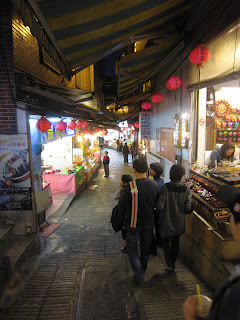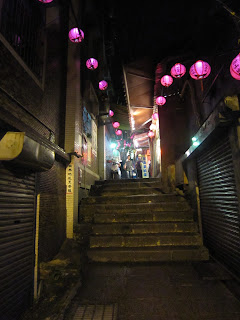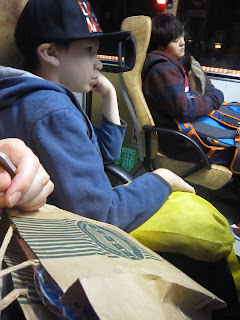Beitou (北投) is an old hot-spring resort area on the northern edge of Taipei, where it benefits from the geo-thermal activity on the edge of Yangming Shan. It was popular with Japanese officials during the Japanese occupation, and had a reputation as something of a red-light district. While the Wikipedia entry is frightfully polite in both English and Chinese and makes no mention of a red-light past, it does inform me that the name derives from a phonetic transcription into Chinese of the original Formosan Aboriginal placename, which apparently meant "witch". Go figure. Today there are no witches apparent to the casual observer, but there's an abundance of hotels and resorts offering natural sulfur spring spas.
Yet again, the Mass Rapid Transit system has made an enormous impact on the task of getting to Beitou. Not only is there a direct train from Taipei Main Station to Beitou, there's then a dedicated line between Beitou and what's called "New Beitou", where the hot springs are located. There must be a lot of money in the area to have justified a dedicated line just to run between two stops.
Our main objective in Beitou was Diregu (地熱谷, which translates as something like "Earth Hot Valley" - no idea why it's "Earth Hot Valley" instead of "Hot Earth Valley"). Diregu is a steaming pool just below the source of a number of hot springs. It used to be popular with tourists to cook eggs and other food in the hot, sulfurous water, but these days the pool is fenced-off to prevent people from burning themselves and polluting the pool with abandoned food. From the MRT station we basically followed the streams up hill on the assumption that they must be flowing out of Diregu. The parks lining the streams are absolutely luxurious by Taiwanese standards - again reflecting the amount of money that the authorities must spend in the area, In one part of the park we found a lillypond that was full of waterlillies and tiny frogs, and spent a decent half-hour sitting watching the frogs.
One of the interesting discoveries for us from this trip was hokutolite (
北投石). Many sources proudly proclaim that hokutolite is the only rock amongst the thousand or so known rocks on Earth that is named after a placename in Taiwan. I have even seen it described as a Taiwanese "National Treasure". Ironically, the name "hokutolite" is actually from the Japanese word for "Beitou" - basically "Beitou stone". The rock was first discovered and named by a Japanese scientist in 1906, who naturally enough gave it an English name based on his Japanese pronunication of "Beitou". The other irony is that I'm not actually entirely sure that hokutolite officially qualifies as a stone - it certainly isn't a mineral. As I understand it, it is a blend of lead-sulfate and barium-sulfate, meaning that the correct name is probably "angleso-barite" - ie barite with anglesite mixed-in. There is no English Wikipedia entry on "hokutolite", although there is an entry in the Chinese version of Wikipedia,
here. Interestingly the Chinese Wikipedia entry says that one of the former Presidents of Academia Sinica did his Masters thesis on hokutolite, so I will be very careful about suggesting that it might not formally exist. My text book on the rocks and minerals of Taiwan tells me that in the past the Diregu area was pillaged by collectors looking for hokutolite samples, and that hokutolite supplies are now essentially exhausted since the vicinity of Beitou stream has been declared a protected area. It goes on to say that residents of the area remain alert for hammering noises in the middle of the night, and occasional arrests are still made. The lengths that some people will go to for mineral samples... The text book (and Chinese Wikipedia) also tells me that hokutolite is only found in two locations in the world - the second being a hot spring area in Japan.
Fresh samples of hokutolite are radioactive due to the presence of traces of radium, although sources state that older samples no longer display any radioactivity due to the rapid decay of the radium. Amusingly, a sign at Diregu proclaimed the "magical health-giving properties" of the radium traces in the spa.
I'm tempted to set-up a Wikipedia entry for hokutolite to see what happens.
After we left Diregu we headed back down the hill to the Hot Springs Museum, in what used to be the old Japanese-era public spa building. The building is a beautiful example of Japanese colonial architecture, with a strong Prussian flavour to it. The spas in the building are no longer open for use - apparently the constant moisture and heat was considered incompatible with ongoing preservation - so today you can walk through the old spas.
In one of the rooms upstairs there was an exhibit talking about the contribution to the development of Beitou by one of the Japanese Governors of Taiwan. He was so popular in the area that the residents paid for a statue of him in a local park. I am thinking that these sorts of acts of love and affection for the Japanese colonial overlords would not have gone down so well with the Nationalists when the Japanese were expelled in 1945. Possibly the economic underpinnings of Beitou were such that it was already hard for the locals to refute accusations that they were collaborators.
In the museum there was also an exhibition on the local movie industry. Apparently the area was the scene for a large number of Taiwanese-language movies in the decade or so after the end of the Japanese occupation. My impression has always been that the speaking of Taiwanese was heavily suppressed by the Nationalists, so it is interesting if there was a significant volume of Taiwanese-language movies being produced in what at the time would have been a tightly-controlled society.
When we came back down from Diregu we stopped for a while in a park to watch some kids playing around a fountain. There was a group of old people sitting in the park there, mostly in wheelchairs, accompanied by their Philippina carers. While I anticipate that the activity was ostensibly related to giving the old people some time out in the park and the fresh air, it seemed pretty clear that the main factor at play was giving the Philippina maids a chance to get together and gossip in Tagalog, occasionally pausing to wipe the dribble off the chins of their charges. It looked like a miserable existence, but I reminded myself that these must have been some of the luckiest and wealthiest old people in Taiwan, and lots of people in their situation were either sitting at home watching television and being looked after by kids, or lying in grim retirement homes. I guess compared to that, sitting in a park listening to Tagalog might not be too bad.







































































